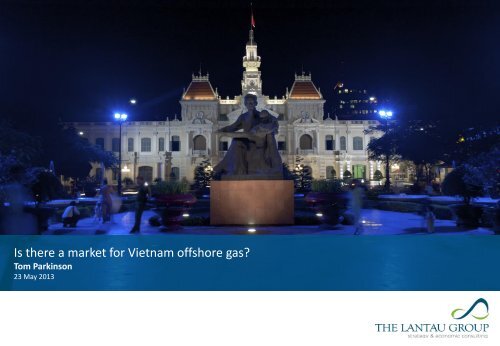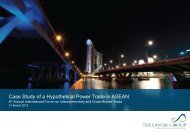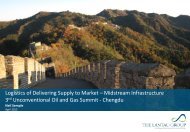Is there a market for Vietnam offshore gas? - The Lantau Group
Is there a market for Vietnam offshore gas? - The Lantau Group
Is there a market for Vietnam offshore gas? - The Lantau Group
- No tags were found...
Create successful ePaper yourself
Turn your PDF publications into a flip-book with our unique Google optimized e-Paper software.
Overview<br />
1<br />
2<br />
3<br />
4<br />
5<br />
Regulatory/policy structure<br />
Power Development Plan VII<br />
Critique of PDP VII assumptions<br />
<strong>The</strong> <strong>Lantau</strong> <strong>Group</strong> (TLG) <strong>for</strong>ecast<br />
Key takeaways<br />
3<br />
<strong>The</strong> <strong>Lantau</strong> <strong>Group</strong>
Effective energy regulation/policy requires a system of checks and balances<br />
Prime Minister<br />
Legislature<br />
National<br />
Policy<br />
Ministry of Energy<br />
Regulator<br />
Energy<br />
Policy<br />
Load Forecasting /<br />
Expansion Planning<br />
Electricity Authority<br />
4<br />
<strong>The</strong> <strong>Lantau</strong> <strong>Group</strong>
By contrast, electricity system in <strong>Vietnam</strong> has few checks and balances<br />
Prime Minister<br />
Ministry of Industry<br />
and Trade (MOIT)<br />
Energy Regulatory<br />
Authority of <strong>Vietnam</strong><br />
Institute <strong>for</strong> Energy<br />
• Load <strong>for</strong>ecast is not an<br />
unbiased estimate of future<br />
load, but rather an<br />
aspirational statement<br />
• Capacity expansion plan<br />
reflects developmental<br />
aspirations, rather than<br />
least-cost solution given<br />
policy constraints<br />
• Rates reflect political<br />
necessities, rather than<br />
underlying costs<br />
<strong>Vietnam</strong> Electricity<br />
(EVN)<br />
5<br />
<strong>The</strong> <strong>Lantau</strong> <strong>Group</strong>
VND/kWh<br />
USD/MWh<br />
<strong>The</strong> constraints on power prices are significant and impair EVN’s viability<br />
Average Retail Electricity<br />
2,500<br />
2,000<br />
1,500<br />
1,000<br />
500<br />
0<br />
Price<br />
Cost<br />
120<br />
100<br />
80<br />
60<br />
40<br />
20<br />
0<br />
• <strong>The</strong>re is an adjustment mechanism<br />
to pass through changes in fuel<br />
costs that EVN calculates, but this<br />
is not implemented.<br />
• Under a Prime Minister decision<br />
(24/2011QD-TTg) in April 2011, the<br />
average electricity price is<br />
supposed to be automatically<br />
adjusted each quarter.<br />
• If the increase is more than 5<br />
percent, then EVN must get<br />
approval from Ministry of Finance<br />
and Ministry of Industry and Trade<br />
• EVN since June 2011 has been<br />
allowed to increase prices by 5<br />
percent each quarter. But lately<br />
this has been 5 percent every six<br />
months.<br />
6<br />
<strong>The</strong> <strong>Lantau</strong> <strong>Group</strong>
Overview<br />
1<br />
2<br />
3<br />
4<br />
5<br />
Regulatory/policy structure<br />
Power Development Plan VII<br />
Critique of PDP VII assumptions<br />
<strong>The</strong> <strong>Lantau</strong> <strong>Group</strong> (TLG) <strong>for</strong>ecast<br />
Key takeaways<br />
7<br />
<strong>The</strong> <strong>Lantau</strong> <strong>Group</strong>
<strong>The</strong> key near-term <strong>gas</strong> supply basins and pipeline networks are in the south<br />
8<br />
<strong>The</strong> <strong>Lantau</strong> <strong>Group</strong>
2010<br />
2011<br />
2012<br />
2013<br />
2014<br />
2015<br />
2016<br />
2017<br />
2018<br />
2019<br />
2020<br />
2021<br />
2022<br />
2023<br />
2024<br />
2025<br />
2026<br />
2027<br />
2028<br />
2029<br />
2030<br />
GWh<br />
In order to replicate the PDP results, we had to “<strong>for</strong>ce-build” units<br />
800,000<br />
700,000<br />
600,000<br />
500,000<br />
400,000<br />
300,000<br />
200,000<br />
100,000<br />
0<br />
Domestic Coal Wind Hydro Gas<br />
LNG PumpedStorage Nuclear Fuel_Oil<br />
Import<br />
Imported Coal<br />
• Overall demand reaches 695 TWh in 2030<br />
(versus 442TWh in our projection)<br />
• Domestic coal levels out after 2020.<br />
• Wind makes a growing presence (50 percent<br />
higher than in TLG <strong>for</strong>ecast)<br />
• Hydro and pumped storage (similar to hydro<br />
in TLG <strong>for</strong>ecast)<br />
• Nuclear contributes 10 percent of generation<br />
by 2030 (whereas we have no nuclear in our<br />
projections)<br />
• Imported coal accounts <strong>for</strong> most of the<br />
baseload growth – a third of the generation in<br />
PDP (versus a sixth in our <strong>for</strong>ecast).<br />
• Competition from other types of generation<br />
and assumed LNG use results in lower<br />
demand <strong>for</strong> domestic <strong>gas</strong> (relative to the TLG<br />
<strong>for</strong>ecast).<br />
9<br />
<strong>The</strong> <strong>Lantau</strong> <strong>Group</strong>
<strong>The</strong> <strong>Lantau</strong> <strong>Group</strong><br />
PDP capacity <strong>for</strong>ecast southeast and southwest<br />
10<br />
Southeast<br />
Southwest<br />
0<br />
10,000<br />
20,000<br />
30,000<br />
40,000<br />
50,000<br />
60,000<br />
70,000<br />
80,000<br />
2010<br />
2011<br />
2012<br />
2013<br />
2014<br />
2015<br />
2016<br />
2017<br />
2018<br />
2019<br />
2020<br />
2021<br />
2022<br />
2023<br />
2024<br />
2025<br />
2026<br />
2027<br />
2028<br />
2029<br />
2030<br />
MW<br />
Southeast_Biofuel<br />
Southeast_CCGT_Gas<br />
Southeast_Coal<br />
Southeast_Geothermal<br />
Southeast_OCGT<br />
Southeast_Hydro<br />
Southeast_ST_Coal<br />
Southeast_ST_Oil<br />
Southeast_Wind<br />
Southeast_Nuclear<br />
0<br />
10,000<br />
20,000<br />
30,000<br />
40,000<br />
50,000<br />
60,000<br />
70,000<br />
80,000<br />
2010<br />
2011<br />
2012<br />
2013<br />
2014<br />
2015<br />
2016<br />
2017<br />
2018<br />
2019<br />
2020<br />
2021<br />
2022<br />
2023<br />
2024<br />
2025<br />
2026<br />
2027<br />
2028<br />
2029<br />
2030<br />
MW<br />
Southwest_Biofuel<br />
Southwest_CCGT_Gas<br />
Southwest_Coal<br />
Southwest_Geothermal<br />
Southwest_OCGT<br />
Southwest_Hydro<br />
Southwest_ST_Coal<br />
Southwest_ST_Oil<br />
Southwest_Wind<br />
Southwest_Nuclear
2011<br />
2012<br />
2013<br />
2014<br />
2015<br />
2016<br />
2017<br />
2018<br />
2019<br />
2020<br />
2021<br />
2022<br />
2023<br />
2024<br />
2025<br />
2026<br />
2027<br />
2028<br />
2029<br />
2030<br />
2031<br />
2010<br />
2011<br />
2012<br />
2013<br />
2014<br />
2015<br />
2016<br />
2017<br />
2018<br />
2019<br />
2020<br />
2021<br />
2022<br />
2023<br />
2024<br />
2025<br />
2026<br />
2027<br />
2028<br />
2029<br />
2030<br />
MW<br />
MW<br />
PDP capacity <strong>for</strong>ecast central and north<br />
Central<br />
North<br />
80,000<br />
80,000<br />
70,000<br />
70,000<br />
60,000<br />
60,000<br />
50,000<br />
50,000<br />
40,000<br />
40,000<br />
30,000<br />
30,000<br />
20,000<br />
20,000<br />
10,000<br />
10,000<br />
0<br />
0<br />
11<br />
Central_Biofuel Central_CCGT_Gas Central_Coal<br />
Central_Geothermal Central_OCGT Central_Hydro<br />
Central_ST_Coal Central_ST_Oil Central_Wind<br />
Central_Nuclear<br />
<strong>The</strong> <strong>Lantau</strong> <strong>Group</strong><br />
North_Biofuel North_CCGT_Gas North_Coal<br />
North_Geothermal North_OCGT North_Hydro<br />
North_ST_Coal North_ST_Oil North_Wind<br />
North_Nuclear
2010<br />
2011<br />
2012<br />
2013<br />
2014<br />
2015<br />
2016<br />
2017<br />
2018<br />
2019<br />
2020<br />
2021<br />
2022<br />
2023<br />
2024<br />
2025<br />
2026<br />
2027<br />
2028<br />
2029<br />
2030<br />
bbtud<br />
PDP South <strong>Vietnam</strong> <strong>gas</strong> demand <strong>for</strong>ecast<br />
2,500<br />
2,000<br />
1,500<br />
1,000<br />
500<br />
• Demand <strong>for</strong> piped <strong>gas</strong> peaks at 1,800<br />
bbtud and then declines as it is displaced<br />
by other fuel sources<br />
• This lowers NamConSon2 pipeline to<br />
between 300 mmcfd to a low of 50<br />
mmcfd and would undermine the<br />
economics of the pipeline (whereas the<br />
TLG <strong>for</strong>ecast supports development)<br />
• LNG comes in by 2018 at 135 bbtud and<br />
rises to 450 bbtud by 2030.<br />
0<br />
CuuLong_Contracted<br />
Southwest_Contracted<br />
NamConSon_Uncontracted<br />
CuuLong_YTF<br />
Southwest_YTF<br />
NamConSon_Contracted<br />
CuuLong_Uncontracted<br />
Southwest_Uncontracted<br />
NamConSon_YTF<br />
LNG<br />
12<br />
<strong>The</strong> <strong>Lantau</strong> <strong>Group</strong>
2010<br />
2011<br />
2012<br />
2013<br />
2014<br />
2015<br />
2016<br />
2017<br />
2018<br />
2019<br />
2020<br />
2021<br />
2022<br />
2023<br />
2024<br />
2025<br />
2026<br />
2027<br />
2028<br />
2029<br />
2030<br />
2010<br />
2011<br />
2012<br />
2013<br />
2014<br />
2015<br />
2016<br />
2017<br />
2018<br />
2019<br />
2020<br />
2021<br />
2022<br />
2023<br />
2024<br />
2025<br />
2026<br />
2027<br />
2028<br />
2029<br />
2030<br />
bbtud<br />
bbtud<br />
PDP southeast and southwest <strong>gas</strong> demand <strong>for</strong>ecast<br />
Southeast<br />
Southwest<br />
2,500<br />
2,500<br />
2,000<br />
2,000<br />
1,500<br />
1,500<br />
1,000<br />
1,000<br />
500<br />
500<br />
0<br />
0<br />
CuuLong_Contracted<br />
CuuLong_Uncontracted<br />
CuuLong_YTF<br />
LNG<br />
NamConSon_Contracted<br />
NamConSon_Uncontracted<br />
NamConSon_YTF<br />
Southwest_Contracted<br />
Southwest_YTF<br />
Southwest_Uncontracted<br />
13<br />
<strong>The</strong> <strong>Lantau</strong> <strong>Group</strong>
2010<br />
2011<br />
2012<br />
2013<br />
2014<br />
2015<br />
2016<br />
2017<br />
2018<br />
2019<br />
2020<br />
2021<br />
2022<br />
2023<br />
2024<br />
2025<br />
2026<br />
2027<br />
2028<br />
2029<br />
2030<br />
2010<br />
2011<br />
2012<br />
2013<br />
2014<br />
2015<br />
2016<br />
2017<br />
2018<br />
2019<br />
2020<br />
2021<br />
2022<br />
2023<br />
2024<br />
2025<br />
2026<br />
2027<br />
2028<br />
2029<br />
2030<br />
bbtud<br />
bbtud<br />
PDP central and north <strong>gas</strong> demand <strong>for</strong>ecast<br />
2,500<br />
Central<br />
2,500<br />
North<br />
2,000<br />
2,000<br />
1,500<br />
1,500<br />
1,000<br />
1,000<br />
500<br />
500<br />
0<br />
0<br />
Central_Contracted Central_Uncontracted Central_YTF<br />
North_Contracted North_Uncontracted North_YTF<br />
14<br />
<strong>The</strong> <strong>Lantau</strong> <strong>Group</strong>
Overview<br />
1<br />
2<br />
3<br />
4<br />
5<br />
6<br />
Regulatory/policy structure<br />
Power Development Plan VII<br />
Critique of PDP VII assumptions<br />
<strong>The</strong> <strong>Lantau</strong> <strong>Group</strong> (TLG) <strong>for</strong>ecast<br />
Key takeaways<br />
Conclusions<br />
15<br />
<strong>The</strong> <strong>Lantau</strong> <strong>Group</strong>
We see three fundamental flaws in the PDP<br />
• <strong>The</strong> load growth <strong>for</strong>ecast is wildly optimistic<br />
• Capacity expansion plan (at least implicitly) uses LNG to meet incremental load<br />
growth – but LNG is not economic relative to alternative resources (and also<br />
assumes nuclear development starting in 2020)<br />
• Ability to pass on LNG costs to consumers appears dubious – and certainly does<br />
not justify use of LNG <strong>for</strong> baseload power<br />
16<br />
<strong>The</strong> <strong>Lantau</strong> <strong>Group</strong>
THOUSANDS OF MEGAWATTS<br />
Optimistic load growth <strong>for</strong>ecasts are endemic to the electricity industry<br />
United States<br />
Asian Country<br />
800<br />
74 75<br />
76<br />
9<br />
700<br />
600<br />
500<br />
400<br />
300<br />
200<br />
100<br />
0<br />
1964<br />
1967<br />
PROJECTED<br />
ACTUAL (64 - 74) = 7.2% p.a.<br />
1970<br />
1973<br />
1976<br />
1979<br />
1982<br />
1985<br />
Source: North American Electric Reliability Council<br />
Electric Power Supply & Demand 1984, p.5<br />
77 78 79<br />
80 81<br />
82 84<br />
83<br />
1988<br />
1991<br />
1994<br />
1997<br />
8<br />
7<br />
6<br />
5<br />
4<br />
3<br />
2<br />
1<br />
0<br />
1975<br />
1978<br />
Source: Client Confidential<br />
85<br />
86<br />
87<br />
89<br />
88<br />
ACTUAL (75 - 85) = 10.1% p.a.<br />
1981<br />
1984<br />
1987<br />
1990<br />
1993<br />
1996<br />
1999<br />
91 92<br />
90 93 94<br />
95/96<br />
97<br />
2002<br />
2005<br />
2008<br />
17<br />
<strong>The</strong> <strong>Lantau</strong> <strong>Group</strong>
<strong>Vietnam</strong> projects much higher load than Thailand, despite much lower GDP<br />
<strong>Vietnam</strong><br />
Thailand<br />
6,000<br />
5,000<br />
GDP per capita<br />
(Constant USD 2000)<br />
KWh per capita<br />
6,000<br />
5,000<br />
GDP per capita<br />
(Constant USD 2000)<br />
KWh per capita<br />
4,000<br />
4,000<br />
PDP Low Forecast<br />
3,000<br />
3,000<br />
2,000<br />
2,000<br />
1,000<br />
1,000<br />
0<br />
2000 2004 2008 2012 2016 2020 2024 2028<br />
0<br />
2000 2004 2008 2012 2016 2020 2024 2028<br />
18<br />
<strong>The</strong> <strong>Lantau</strong> <strong>Group</strong>
Our TLG <strong>for</strong>ecast reduces the load growth rate substantially<br />
6,000<br />
5,000<br />
GDP per capita<br />
(Constant USD 2000)<br />
KWh per capita<br />
• <strong>The</strong> low PDP generation <strong>for</strong>ecast<br />
looks way over-ambitious compared<br />
to economic growth<br />
4,000<br />
3,000<br />
2,000<br />
1,000<br />
PDP Low<br />
Forecast<br />
TLG<br />
Forecast<br />
• We have assumed the same<br />
underlying GDP growth rate (6.5%<br />
average annual expansion the<br />
economy to 2030) as assumed <strong>for</strong><br />
the low PDP <strong>for</strong>ecast<br />
• We have assumed an average<br />
elasticity of power generation<br />
growth to economic growth of 1.2<br />
times through to 2030 (versus an<br />
average of 1.6 times <strong>for</strong> the low<br />
PDP <strong>for</strong>ecast) – and we feel even<br />
this assumption is aggressive.<br />
0<br />
2000 2004 2008 2012 2016 2020 2024 2028<br />
19<br />
<strong>The</strong> <strong>Lantau</strong> <strong>Group</strong>
Gas prices will be limited by the competition between coal and <strong>gas</strong> economics<br />
Plant Type<br />
Plant Details and Capital Cost<br />
Gas CCGT<br />
Coal Greenfield<br />
State of Art<br />
Indonesian Subbituminous<br />
Generic USD/kW 900 1,600<br />
Economic Life (years) 25 30<br />
Capacity Factor (%) 85 85<br />
Fixed Cost<br />
Capex (USD/MWh) 17 32<br />
Fixed O&M per MWh 2 3<br />
Fixed (USD/MWh) 19 36<br />
Fuel Costs Gas Coal<br />
Gross Fuel Cost (HHV) (USD/mmbtu) 9.1 4.8<br />
Heat Rate (mmbtu/MWh) 6.9 9.0<br />
Variable Costs<br />
Variable O&M per MWh 2 4<br />
Fuel per MWh 64 45<br />
Variable (USD/MWh) 66 49<br />
• State-of-the-art technology and Indonesia<br />
sub-bituminous coal<br />
• Plant competing <strong>for</strong> base load with average<br />
capacity factor of 85 percent<br />
• Use the economics of the new build coal<br />
plant to determine the competing price <strong>for</strong><br />
delivered <strong>gas</strong><br />
• This would be <strong>gas</strong> delivered to a new build<br />
combined cycle <strong>gas</strong> turbine<br />
• Should be willing to pay up to USD 9.10/<br />
mmbtu delivered <strong>for</strong> <strong>gas</strong>.<br />
• This indicates a range of USD 8.10 to 7.85/<br />
mmbtu upstream.<br />
LRMC (USD/MWh) 85 85<br />
20<br />
<strong>The</strong> <strong>Lantau</strong> <strong>Group</strong>
<strong>The</strong> use of Chinese technology would <strong>for</strong>ce the breakeven <strong>gas</strong> price even lower<br />
Plant Type<br />
Gas CCGT<br />
Coal Greenfield<br />
China Technology<br />
Indonesian Low<br />
Ranked<br />
• If the coal plant uses less expensive China<br />
technology, then the capital expenditure<br />
comes down.<br />
Plant Details and Capital Cost<br />
Generic USD/kW 900 1,000<br />
Economic Life (years) 25 30<br />
Capacity Factor (%) 85 85<br />
Fixed Cost<br />
Capex (USD/MWh) 17 20<br />
Fixed O&M per MWh 2 3<br />
Fixed (USD/MWh) 19 24<br />
• This also brings down the price at which <strong>gas</strong><br />
would compete to displace the new build<br />
coal plant.<br />
• USD 7.40/mmbtu delivered <strong>for</strong> <strong>gas</strong> means<br />
an upstream price in the range of USD 6.40<br />
to 6.15/mmbtu.<br />
Fuel Costs Gas Coal<br />
Gross Fuel Cost (HHV) (USD/mmbtu) 7.4 4.8<br />
Heat Rate (mmbtu/MWh) 6.9 9.2<br />
Variable Costs<br />
Variable O&M per MWh 2 4<br />
Fuel per MWh 52 46<br />
Variable (USD/MWh) 54 49<br />
LRMC (USD/MWh) 73 73<br />
21<br />
<strong>The</strong> <strong>Lantau</strong> <strong>Group</strong>
Breakeven Gross Gas Price (USD/mmbtu)<br />
Including a carbon value would raise the breakeven price of baseload <strong>gas</strong><br />
18<br />
16<br />
Gross LNG Price<br />
14<br />
12<br />
Against<br />
Advanced<br />
Coal<br />
10<br />
8<br />
Against<br />
Chinese Coal<br />
6<br />
4<br />
2<br />
22<br />
<strong>The</strong> <strong>Lantau</strong> <strong>Group</strong><br />
0<br />
0 20 40 60 80 100<br />
Carbon Shadow Price (USD/tonne)
Annual Cost (USD 000's/MW-year)<br />
CCGTs burning LNG would only be economic at very low capacity factors<br />
800<br />
700<br />
LNG Breakeven<br />
Capacity Factor<br />
600<br />
500<br />
400<br />
300<br />
200<br />
100<br />
CCGT @ 7.40/mmbtu<br />
CCGT @ 9.10/mmbtu<br />
CCGT @ LNG Price<br />
Advanced Coal<br />
Chinese Coal<br />
0<br />
0 20 40 60 80 100<br />
Capacity Factor (percent)<br />
23<br />
<strong>The</strong> <strong>Lantau</strong> <strong>Group</strong>
PVN’s plan is to create WACOG pools so as to direct subsides to specific users<br />
Source: Petro<strong>Vietnam</strong> Gas, Challenges <strong>for</strong> Balancing Gas Supply and Demand, 4 July 2012<br />
24<br />
<strong>The</strong> <strong>Lantau</strong> <strong>Group</strong>
Overview<br />
1<br />
2<br />
3<br />
4<br />
5<br />
Regulatory/policy structure<br />
Power Development Plan VII<br />
Critique of PDP VII assumptions<br />
<strong>The</strong> <strong>Lantau</strong> <strong>Group</strong> (TLG) <strong>for</strong>ecast<br />
Key takeaways<br />
25<br />
<strong>The</strong> <strong>Lantau</strong> <strong>Group</strong>
2010<br />
2011<br />
2012<br />
2013<br />
2014<br />
2015<br />
2016<br />
2017<br />
2018<br />
2019<br />
2020<br />
2021<br />
2022<br />
2023<br />
2024<br />
2025<br />
2026<br />
2027<br />
2028<br />
2029<br />
2030<br />
GWh<br />
Imported coal is the “swing resource” in the generation mix<br />
500,000<br />
450,000<br />
400,000<br />
350,000<br />
300,000<br />
250,000<br />
• Domestic coal supply into power levels off<br />
around 2020 – and this allows <strong>for</strong> reduced<br />
exports and also some degree of<br />
underground mining.<br />
• Southeast <strong>Vietnam</strong> has some of the best wind<br />
potential in Southeast Asia, but incentives will<br />
be needed.<br />
200,000<br />
150,000<br />
100,000<br />
50,000<br />
0<br />
Domestic Coal Wind Hydro<br />
Gas Biofuel Fuel_Oil<br />
Diesel Import Imported Coal<br />
• Hydro (including imported hydro) expands to<br />
2020 then the rate of growth declines.<br />
• Domestic <strong>gas</strong> shows relatively good growth<br />
but some committed southern coal plants<br />
hamper <strong>gas</strong> sales through to 2020<br />
• Beyond 2020 we let the economics of the<br />
simulation take over; <strong>gas</strong> competes with coal<br />
in the south, but in the north the sheer level of<br />
power demand requires substantial coal build<br />
– <strong>there</strong> is limited supply of <strong>gas</strong> in the north.<br />
26<br />
<strong>The</strong> <strong>Lantau</strong> <strong>Group</strong>
<strong>The</strong> <strong>Lantau</strong> <strong>Group</strong><br />
TLG capacity <strong>for</strong>ecast in southeast and southwest<br />
27<br />
Southeast<br />
Southwest<br />
0<br />
10,000<br />
20,000<br />
30,000<br />
40,000<br />
50,000<br />
2010<br />
2011<br />
2012<br />
2013<br />
2014<br />
2015<br />
2016<br />
2017<br />
2018<br />
2019<br />
2020<br />
2021<br />
2022<br />
2023<br />
2024<br />
2025<br />
2026<br />
2027<br />
2028<br />
2029<br />
2030<br />
MW<br />
Southeast_Biofuel<br />
Southeast_CCGT_Gas<br />
Southeast_Coal<br />
Southeast_Geothermal<br />
Southeast_OCGT<br />
Southeast_Hydro<br />
Southeast_ST_Coal<br />
Southeast_ST_Oil<br />
Southeast_Wind<br />
Southeast_Nuclear<br />
0<br />
10,000<br />
20,000<br />
30,000<br />
40,000<br />
50,000<br />
2010<br />
2011<br />
2012<br />
2013<br />
2014<br />
2015<br />
2016<br />
2017<br />
2018<br />
2019<br />
2020<br />
2021<br />
2022<br />
2023<br />
2024<br />
2025<br />
2026<br />
2027<br />
2028<br />
2029<br />
2030<br />
MW<br />
Southwest_Biofuel<br />
Southwest_CCGT_Gas<br />
Southwest_Coal<br />
Southwest_Geothermal<br />
Southwest_OCGT<br />
Southwest_Hydro<br />
Southwest_ST_Coal<br />
Southwest_ST_Oil<br />
Southwest_Wind<br />
Southwest_Nuclear
2011<br />
2013<br />
2015<br />
2017<br />
2019<br />
2021<br />
2023<br />
2025<br />
2027<br />
2029<br />
2031<br />
2010<br />
2011<br />
2012<br />
2013<br />
2014<br />
2015<br />
2016<br />
2017<br />
2018<br />
2019<br />
2020<br />
2021<br />
2022<br />
2023<br />
2024<br />
2025<br />
2026<br />
2027<br />
2028<br />
2029<br />
2030<br />
MW<br />
MW<br />
TLG capacity <strong>for</strong>ecast in central and north<br />
Central<br />
North<br />
50,000<br />
50,000<br />
40,000<br />
40,000<br />
30,000<br />
30,000<br />
20,000<br />
20,000<br />
10,000<br />
10,000<br />
0<br />
0<br />
Central_Biofuel<br />
Central_Coal<br />
Central_OCGT<br />
Central_ST_Coal<br />
Central_Wind<br />
Central_CCGT_Gas<br />
Central_Geothermal<br />
Central_Hydro<br />
Central_ST_Oil<br />
Central_Nuclear<br />
North_Biofuel North_CCGT_Gas North_Coal<br />
North_Geothermal North_OCGT North_Hydro<br />
North_ST_Coal North_ST_Oil North_Wind<br />
North_Nuclear<br />
28<br />
<strong>The</strong> <strong>Lantau</strong> <strong>Group</strong>
2010<br />
2011<br />
2012<br />
2013<br />
2014<br />
2015<br />
2016<br />
2017<br />
2018<br />
2019<br />
2020<br />
2021<br />
2022<br />
2023<br />
2024<br />
2025<br />
2026<br />
2027<br />
2028<br />
2029<br />
2030<br />
bbtud<br />
TLG South <strong>Vietnam</strong> <strong>gas</strong> balance<br />
3,000<br />
2,500<br />
2,000<br />
1,500<br />
1,000<br />
500<br />
• Some coal build dents demand between 2017<br />
to 2021.<br />
• But <strong>there</strong> is enough <strong>gas</strong> through to 2027<br />
be<strong>for</strong>e supplies dip.<br />
• Transmission of large amounts of “<strong>gas</strong> by<br />
wire” say from central is not really possible<br />
due to limited power transmission.<br />
• <strong>The</strong>re<strong>for</strong>e, it is not until 2027 that we <strong>for</strong>esee<br />
the window would open <strong>for</strong> LNG on an<br />
economic basis <strong>for</strong> the power sector in the<br />
south.<br />
0<br />
CuuLong_Contracted<br />
Southwest_Contracted<br />
NamConSon_Uncontracted<br />
CuuLong_YTF<br />
Southwest_YTF<br />
NamConSon_Contracted<br />
CuuLong_Uncontracted<br />
Southwest_Uncontracted<br />
NamConSon_YTF<br />
29<br />
<strong>The</strong> <strong>Lantau</strong> <strong>Group</strong>
2010<br />
2011<br />
2012<br />
2013<br />
2014<br />
2015<br />
2016<br />
2017<br />
2018<br />
2019<br />
2020<br />
2021<br />
2022<br />
2023<br />
2024<br />
2025<br />
2026<br />
2027<br />
2028<br />
2029<br />
2030<br />
2010<br />
2011<br />
2012<br />
2013<br />
2014<br />
2015<br />
2016<br />
2017<br />
2018<br />
2019<br />
2020<br />
2021<br />
2022<br />
2023<br />
2024<br />
2025<br />
2026<br />
2027<br />
2028<br />
2029<br />
2030<br />
bbtud<br />
bbtud<br />
TLG <strong>gas</strong> demand <strong>for</strong>ecast in southeast and southwest<br />
Southeast<br />
Southwest<br />
2,000<br />
2,000<br />
1,800<br />
1,800<br />
1,600<br />
1,600<br />
1,400<br />
1,400<br />
1,200<br />
1,200<br />
1,000<br />
800<br />
600<br />
400<br />
200<br />
0<br />
1,000<br />
800<br />
600<br />
400<br />
200<br />
0<br />
CuuLong_Contracted<br />
NamConSon_Contracted<br />
Southwest_Contracted<br />
Southwest_Uncontracted<br />
CuuLong_Uncontracted<br />
NamConSon_Uncontracted<br />
Southwest_YTF<br />
CuuLong_YTF<br />
NamConSon_YTF<br />
30<br />
<strong>The</strong> <strong>Lantau</strong> <strong>Group</strong>
2010<br />
2011<br />
2012<br />
2013<br />
2014<br />
2015<br />
2016<br />
2017<br />
2018<br />
2019<br />
2020<br />
2021<br />
2022<br />
2023<br />
2024<br />
2025<br />
2026<br />
2027<br />
2028<br />
2029<br />
2030<br />
2010<br />
2011<br />
2012<br />
2013<br />
2014<br />
2015<br />
2016<br />
2017<br />
2018<br />
2019<br />
2020<br />
2021<br />
2022<br />
2023<br />
2024<br />
2025<br />
2026<br />
2027<br />
2028<br />
2029<br />
2030<br />
bbtud<br />
bbtud<br />
TLG <strong>gas</strong> demand <strong>for</strong>ecast in north and central<br />
Central<br />
North<br />
2,000<br />
2,000<br />
1,800<br />
1,800<br />
1,600<br />
1,600<br />
1,400<br />
1,400<br />
1,200<br />
1,200<br />
1,000<br />
1,000<br />
800<br />
800<br />
600<br />
600<br />
400<br />
400<br />
200<br />
200<br />
0<br />
0<br />
Central_Contracted Central_Uncontracted Central_YTF<br />
North_Contracted North_Uncontracted North_YTF<br />
31<br />
<strong>The</strong> <strong>Lantau</strong> <strong>Group</strong>
Overview<br />
1<br />
2<br />
3<br />
4<br />
5<br />
Regulatory/policy structure<br />
Power Development Plan VII<br />
Critique of PDP VII assumptions<br />
<strong>The</strong> <strong>Lantau</strong> <strong>Group</strong> (TLG) <strong>for</strong>ecast<br />
Key takeaways<br />
32<br />
<strong>The</strong> <strong>Lantau</strong> <strong>Group</strong>
Conclusions<br />
• Power Development Plan VII appears wildly optimistic<br />
– Load <strong>for</strong>ecast – even the low case! – is simply not credible<br />
– Capacity expansion plan appears to <strong>for</strong>ce development of resources – particularly baseload CCGTs<br />
burning LNG – that are not economic relative to alternatives<br />
– Rationale to use LNG appears to rest on a price-discrimination scheme that may enable PVN to cover<br />
the cost of LNG, but hardly justifies its use <strong>for</strong> baseload power<br />
• Realistic capacity expansion makes full use of domestic <strong>gas</strong> and pushes off need<br />
<strong>for</strong> LNG – at least <strong>for</strong> baseload power – until about 2027<br />
• Competition between baseload <strong>gas</strong> and coal will set “ceiling prices” <strong>for</strong> upstream<br />
domestic <strong>offshore</strong> <strong>gas</strong>:<br />
– Against Chinese coal technology, ceiling prices would be in the range of USD 6.15-6.40/mmbtu<br />
– Against advanced coal technology, ceiling prices rise to USD 7.85-8.10/mmbtu<br />
– If carbon is valued explicitly, breakeven prices rise USD 0.74/mmbtu <strong>for</strong> every USD 10/tonne increase<br />
in the carbon price<br />
– Without a carbon value, CCGTs burning LNG would only be economic as peaking units; moreover, <strong>for</strong><br />
any <strong>for</strong>eseeable carbon value, they would not be economic as baseload units.<br />
33<br />
<strong>The</strong> <strong>Lantau</strong> <strong>Group</strong>
Power<br />
Utilities<br />
Energy<br />
For more in<strong>for</strong>mation please contact us:<br />
Insight<br />
Rigour<br />
Value<br />
Tom PARKINSON<br />
tparkinson@lantaugroup.com<br />
Neil SEMPLE<br />
nsemple@lantaugroup.com<br />
+852 2521 5501 (office)<br />
www.lantaugroup.com<br />
www.lantaugroup.com<br />
<strong>The</strong> <strong>Lantau</strong> <strong>Group</strong> (HK) Limited<br />
4602-4606 Tower 1, Metroplaza<br />
223 Hing Fong Road<br />
Kwai Fong, Hong Kong<br />
Hong Kong<br />
Tel: +852 2521 5501










